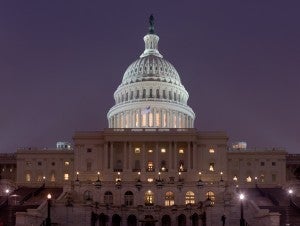Authored by Erica Morehouse, Senior Attorney, U.S. Climate Policy and Analysis
Oregon is the current bellwether for climate action in the United States thanks to its effort to place an ambitious, firm limit on all major sources of climate pollution in the state. HB 2020, Oregon’s “Cap and Invest” bill has passed three major legislative hurdles this year and has the final and most challenging – passage in the state Senate – left to clear before the end of session on June 30. We are expecting a vote today.
The status quo is not an option
Oregon is already seeing the devastating effects of climate change; the question is only how much worse it is going to get before we transition to the clean economy we need. It’s time to be honest with ourselves, the status quo is not an option. HB 2020 lays out a solution to address climate pollution while providing a smooth transition for Oregonians directly impacted by this bold initiative. These features include assistance for low-income Oregonians, investments in worker transition programs, compliance cost reductions for many manufacturers designed to protect jobs, and a novel investment set aside for tribes.
The two most critical components of Oregon’s policy
In the final weeks of Oregon’s legislative session, opponents tried and failed to make amendments to the bill that would have gutted the core of what makes Oregon’s effort so ambitious and critical—and a true model for other states to follow: the interim 2035 target and Day 1 coverage of the transportation sector.
- The 2035 interim target ensures reductions over the next decade on the timescale that science demands. The IPCC report tells us we have just over a decade to significantly reduce climate pollution and avoid the most catastrophic effects of climate change. Setting ambitious targets for the 2030s is essential for getting reductions on track now, and achieving the critical early emission reductions people and the planet need. Also, having an ambitious target in the 2030s is almost certainly a non-negotiable prerequisite for linking with the California-Quebec WCI market – a stated priority for the architects of Oregon’s policy. Moreover, this level of ambition is consistent with Colorado’s recently passed statutory requirement to reduce statewide greenhouse gas emissions 50% below 2005 levels by 2030.
- Coverage of the transportation sector means the largest source of Oregon’s pollution is included. Exempting the rising emissions of this sector means smaller industries would have to do even more to reduce emissions to meet Oregon’s goals, while giving the biggest polluters a free pass. Without the transportation sector in the program from day one, Cap and Invest will not have the power or reach to drive the transformational change that we literally cannot live without.
Climate action under attack
After failing to push their disastrous amendments, opponents are now set on undermining this bill altogether and are asking legislators to vote “no”. Leading the charge against HB 2020 are Boeing and AAA. AAA claims to be the travelers “most trusted advocate”, but it is unlikely that their members across Oregon who rely on them for towing services and roadside assistance understand that they are working actively in Salem to undermine an effort to get cleaner cars on the road and to diversify transportation options for Oregonians. Boeing’s opposition is also particularly hard to understand. Final amendments to the bill put Boeing in the enviable position of being guaranteed valuable free allowances for their facility in Gresham that will significantly, if not completely, reduce costs the company might have seen from the program while creating a critical market-based incentive to improve efficiency and reduce emissions associated with their production practices while protecting incentives to increase output. Yet, the company is lobbying against climate policy that is in line with corporate sustainability commitments they have already made. Many companies have taken on ambitious voluntary, climate commitments and vocally supported climate action including in Oregon. Companies that are stuck in the past and insist on obfuscating, misleading, and outright obstructing to derail climate action should be held accountable.
A diverse coalition of stakeholders reflects a fine-tuned policy
As demoralizing as myopic opposition can be, Oregon has a winning coalition that can provide lessons on how to win on climate in the U.S. and around the world:
- Legislative leaders and Governor Kate Brown have provided their full throated support for Cap and Invest for well over a year and have been diligently putting the pieces in place to pass a policy that can deliver the environmental outcomes the climate needs while ensuring the provisions are carefully tailored for Oregon communities.
- Local environmental, environmental justice, and health leaders have been working hard for the better part of a decade to pass companion legislation and lay the groundwork for such an overarching policy like HB2020 that will provide the certainty around pollution outcomes and harness the power of the market to drive investment and innovation in clean technologies.
- Over 100 forward-looking businesses, including major companies like Nike and Uber, have been supporting the policy through several legislative iterations.
- Major electric and gas utilities—those that power and heat Oregon’s homes and businesses—are supporting the legislation, including Portland General Electric, Pacific Power, and Northwest Natural, citing key consumer-protection provisions.
- Oregon’s Native American tribes have played a critical role in developing and advocating for the policy and have secured a novel set aside from carbon revenue that will directly benefit tribes.
- Key labor unions such as the building trades also support Cap and Invest, after securing the inclusion of prevailing wage provisions.
Time for the Senate To Act
Oregon has all of the ingredients for success, but the political fight is still a bitter one. HB2020 will create tangible benefits for Oregonians and the state’s economy—while laying out a clear policy template for other states who are now committing to strong reduction targets but don’t yet have the regulations or policies in place to actually achieve the reductions in climate pollution that we know are necessary. It’s imperative that Oregon shows the way toward a real solution that can drive action now— and such a framework will not only chart a path for other states, but provide a real roadmap for future federal action.










 This post was written by EDF attorney Laura Shields
This post was written by EDF attorney Laura Shields 

